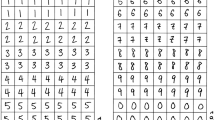Abstract
Converting real written data and information into digital form for storage in a digital format necessitates the use of expensive manual labor. The paper aims to debate a response to some of the issues since the spectrum has been limited to just handwritten digits (0–9). The ‘MNIST DATASET,’ which includes training and test datasets for handwritten digits (0–9) with a resolution of (28 × 28), or 784 pixels, was used. The MNIST data set contains 60,000 training data and 10,000 test data.
Access this chapter
Tax calculation will be finalised at checkout
Purchases are for personal use only
Similar content being viewed by others
References
Wu M, Zhang Z, Handwritten digit classification using the MNIST dataset (2010)
A. Dutta, Handwritten digit recognition using deep learning. Int. J. Adv. Res. Comput. Eng. & Technol. (IJARCET) 6(7) (2017)
N. Dalal, B. Triggs, Histograms of oriented gradients for human detection. Proceedings of the IEEE Computer Society Conference on Computer Vision and Pattern Recognition (CVPR ’05), vol. 1 (San Diego, CA, USA, 20–26 June 2005) pp. 886–893
D.G. Lowe, Distinctive image features from scale-invariant keypoints. Int. J. Comput. Vis. 60, 2 (2004)
Y. LeCun et al., Backpropagation applied to handwritten zip code recognition. Neural Comput. 1(4), 541–551 (1989)
R Ravi Kumar, M. Babu Reddy, P. Praveen, Text classification performance analysis on machine learning. Int. J. Adv. Sci. Technol. 28(20), pp. 691–697, (2019)
“MatConvNet Convolutional Neural Networks for MATLAB” Andrea Vedaldi, Karel Lenc, Ankush Gupta
K. Jarrett, K. Kavukcuoglu, M.A. Ranzato, Y. LeCun, What is the best multi-stage architecture for object recognition, CCV’09, IEEE (2009)
R. Hadsell, S. Chopra, Y. LeCun, Dimensionality reduction by learning an invariant mapping. CVPR 2, 1735–1742 (2006)
H.W. Ian, E. Frank, Data Mining: Practical Machine Learning Tools and Techniques, 2nd edn. (Morgan Kaufmann, San Francisco, CA, USA, 2005)
N. Otsu, A threshold selection method from gray-level histograms. IEEE Trans. Syst. Man Cybern. 9(1), 62–66 (1979)
F.C. Ribas, L.S. Oliveira, A.S. Britto, R. Sabourin, Handwritten digit segmentation: A comparative study. Int. J. Doc. Anal. Recognit. IJDAR 16(2), 127–137 (2013)
Praveen, C. Jayanth Babu, Big data clustering: applying conventional data mining techniques in Big Data environment. Innovations in Computer Science and Engineering, Lecture Notes in Networks and Systems 74, ISSN 2367-3370 (Springer, Singapore, 2019). https://doi.org/10.1007/978-981-13-7082-3_58
K. Bansal, R.G. Kumar, “Cleaning and recognition of numerals in a handwritten Devnagari document consisting of roll numbers and marks, PhD Thesis (2012)
J. Schmidhuber, Deep learning in neural networks: An overview. Neural Netw. 61, 85–117 (2015)
P. Praveen, C.J. Babu, B. Rama, Big data environment for geospatial data analysis. 2016 International Conference on Communication and Electronics Systems (ICCES), Coimbatore, 2016, pp. 1–6. https://doi.org/10.1109/CESYS.2016.7889816
B. Rama, P. Praveen, H. Sinha, T. Choudhury, A study on causal rule discovery with PC algorithm. 2017 International Conference on Infocom Technologies and Unmanned Systems (Trends and Future Directions) (ICTUS), Dubai (2017), pp. 616–621. https://doi.org/10.1109/ICTUS.2017.8286083
Author information
Authors and Affiliations
Editor information
Editors and Affiliations
Rights and permissions
Copyright information
© 2022 The Author(s), under exclusive license to Springer Nature Singapore Pte Ltd.
About this paper
Cite this paper
Praveen, P., Abhishek, N., Reddy, K.J., Raj, C.T., Reddy, A.Y. (2022). A Predictive Model of Handwritten Digits Recognition Using Expert Systems. In: Ranganathan, G., Fernando, X., Shi, F., El Allioui, Y. (eds) Soft Computing for Security Applications . Advances in Intelligent Systems and Computing, vol 1397. Springer, Singapore. https://doi.org/10.1007/978-981-16-5301-8_43
Download citation
DOI: https://doi.org/10.1007/978-981-16-5301-8_43
Published:
Publisher Name: Springer, Singapore
Print ISBN: 978-981-16-5300-1
Online ISBN: 978-981-16-5301-8
eBook Packages: Intelligent Technologies and RoboticsIntelligent Technologies and Robotics (R0)




